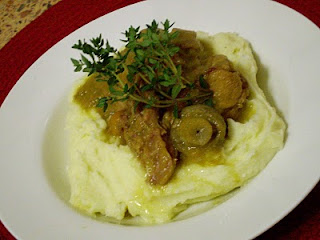Regular readers will recall that when I was Paris recently, I had the opportunity to cook rabbit - a meat I really love and one that I think is overlooked and underused in Australia. The meat is very lean, beautifully tasty and really lends itself to a flavoursome and comforting winter dish. I came up with this recipe a couple of weekends ago when I was spending the weekend on the Central Coast of New South Wales and purchased a wild rabbit. I decided to create something new that satisfied my desire for comfort food. What I came up with was this slow braised rabbit, flavoured with herbs, mushrooms, eschallots, bacon and proscuitto - and given a bit of zing with a touch Dijon mustard and a splash of dry vermouth. The result was just delicious - the sauce is to die for. Don't waste it - I served the dish with super creamy potato mash so that we got every last drop.
Look, if you are a bit skittish about eating rabbit (and I know many people are) you could easily do this with skinless chicken pieces as a substitute. But - if you have never eaten rabbit, this would be a great way to give it a try. I have used wild rabbit in my recipe - it tends to have a stronger flavour - but you will mostly find that rabbits sold in Australia are farmed and will have milder tasting flesh. Check with your butcher who will be able to tell you whether yours is the farmed kind of one of the wild ones. I bought my rabbit skinless, gutted and whole (with the kidneys left in) - I preferred to butcher it myself now that I know how, after learning when I was in France - but your butcher can do it for you if you would rather not.
I made my own Bouquet Garni to flavour this recipe (instructions below) but if you really can't be bothered, you can buy Bouquet Garni sachets from the supermarket - although I can't promise that the herbal flavour will be as nice as using the fresh product, it should still be ok.
This style of dish is even better if you make it the day before you want to serve it - it allows the flavours to develop further and is perfect for entertaining. Make it when you have time and then just reheat when your guests arrive. This will freeze well too. I used a heavy cast iron/enamel pan to cook my rabbit dish - something that can go from stovetop to oven is ideal. Who wants to fiddle around with extra pots? I don't. So here it is, served with buttery mash....
GG slow braised rabbit with mushrooms, bacon and proscuitto
You will need: 1 whole rabbit (I used a wild one for this recipe but most that you buy these days will be farmed), 1 cup diced celery, 1 cup diced carrot, 1 cup sliced leeks, 10-15 whole peeled eschallots, 10-15 button mushrooms, 4 slices roughly chopped proscuitto, 3 slices roughly chopped streaky bacon with the rind removed, 3 or 4 cloves garlic, 2 bay leaves, 6-8 sprigs fresh thyme, 6-8 sprigs parsley(with stalks), kitchen twine (to tie up the herbs with), a square of muslin or cheesecloth about 12cm square, 1L chicken stock, 1/3 cup dry Vermouth, 1/2 tablespoon Dijon mustard, a generous splash of olive oil, 1 tablespoon butter, salt and pepper.
Method:
First, you will need to cut the rabbit into 6 pieces. Remove the front and back legs (with the thigh attached) and set them aside. Now remove the large fleshy part that remains at the back end of the rabbit (this is the "saddle"). Cut this into two halves. The rest of the rabbit/bones can be frozen for use in making stock another time - it will have very little meat on it. Before you do though, have a look inside the cavity - if your butcher has left the kidneys attached, gently cut them off and dice them finely. They will add to the lovely layers of flavour in the dish. If they have already been removed, no problem - the dish will still work well. And of course, if the thought of trying to butcher a rabbit is a bit much - ask your butcher to do it for you!
Now, make the Bouquet Garni - take the parsley, thyme and bay leaves, place them in the cloth and tie them up in a bundle securely with a piece of kitchen twine.
Season the rabbit pieces with pepper and a bit of salt. Heat a generous splash of olive oil in the pan and brown the rabbit pieces in batches of 3. Remove the rabbit from the pan and set aside. Add the bacon and proscuitto, chopped kidneys (if used) leeks, carrots, celery and escallots to the pan and allow to cook for about 5 minutes. Now add the garlic and Bouquet Garni and cook for another 5 minutes. Splash in the Vermouth and allow it to bubble up, realising all those lovely precious caramelised bits on the bottom of the pan.
Add the stock and stir it in well. Cover the pan and bake in a moderate oven for 1 1/2 hours, stirring every half an hour or so. If the dish is drying out too much, add a bit of water to the pan.
Add the mushrooms, Dijon mustard and butter and allow to cook for at least another 1/2 hour. to 45mins. Taste for seasoning and add more salt and pepper if necessary.
Serve with creamy mash and a sprig of fresh thyme.
******












